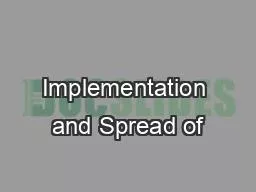

Multilevel Interventions in Practice Implications for the Cancer Care Continuum Elizabeth M Yano PhD MSPH VA Greater Los Angeles HSRampD Center of Excellence UCLA School of Public Health ID: 809225
Download The PPT/PDF document "Implementation and Spread of" is the property of its rightful owner. Permission is granted to download and print the materials on this web site for personal, non-commercial use only, and to display it on your personal computer provided you do not modify the materials and that you retain all copyright notices contained in the materials. By downloading content from our website, you accept the terms of this agreement.
Slide1
Implementation and Spread of Multilevel Interventions in Practice: Implications for the Cancer Care Continuum
Elizabeth M. Yano, PhD, MSPHVA Greater Los Angeles HSR&D Center of ExcellenceUCLA School of Public Health
Center for the Study of
Healthcare Provider Behavior
Slide2Co-AuthorsLawrence W. Green, DrPH (UCSF)Karen Glanz, PhD, MPH (U Penn)
John Z. Ayanian, MD, MPP (Harvard Med)Brian S. Mittman, PhD (VA CIPRS)Veronica Chollette, RN, MS (NCI)Lisa V. Rubenstein, MD, MSPH (VA, UCLA, RAND)
Slide3IntroductionScientific evidence about what works in health care takes decades to move to routine careEvidence is flawed
tested under highly controlled and homogenized circumstancesApplied to real world settings “voltage drop”Greater recognition of contextual influences underlying intervention success (or failure)Motivated interventions that target context levels (patients, providers, practices, communities, policy)
Few multilevel interventions (MLIs) conducted along cancer continuum fewer implemented
Slide4Implementation and SpreadHow is implementation different?Not testing the original efficacious intervention
Testing a set of strategies for deploying the MLIAdapted to different contexts (settings, levels)Focused on activities that facilitate uptake of MLIRequires engagement/involvement of wide range of stakeholdersPartners in implementation at each level
Researchers’ capacity to influence determined by handoffs and support constructed through partnersCreating new ways of “doing business”
Slide5ApproachIdentified cancer and non-cancer MLI exemplarsSpan different levels and different stages of care continuum
VHA Colorectal Cancer Care Collaborative
Pool Cool Diffusion Trial
Comprehensive Tobacco Control Programs
Depression Collaborative Care Models
CHOICE
(Cancer Education)
Improving Systems for CRC Screening
Slide6Slide7Implementation and Spread of MLIsCombinations, phases of MLI implementationAttend to stakeholders at each level
Understand how levels may interact Create inter-dependencies (e.g., local funding based on mapping to state-level program activities)Determine quality of evidence for interventions at each level (in lieu of evidence, blend experience)
Use social marketing for interventional messagingUse PDSA pilots to test within/across levels Consider staged approaches, give adequate time
Top-down and bottom-up implementation
Slide8Implementation and Spread of MLIsPartnerships within and across levelsResearch-clinical partnerships essential
Reduced researcher control over implementationShared knowledge, trust, role specificationTeam building before, during, after MLI implementationContinual identification of stakeholders in network
Strong leadership support at each level, over timeHelp elucidate other key playersAccountableRole in coalition building
Partnerships with health IT staff (e.g., in EMR
sites)
Slide9Implementation and Spread of MLIsImplementation facilitatorsOrganizational supports (e.g., direct grants, special funding allocations, protected time for QI)
May be centralized (e.g., state media campaign for tobacco control) or shared (e.g., EMR support)Implementation barriersImplementation requiring interdisciplinary cooperation may be met with resistance“Turf” (especially if competition for resources exists)“Silos” (must create communication/coordination
mechanisms)Perceived value of MLI balanced with competing demands among busy members at each level
Slide10Implementation and Spread of MLIsPolicy context, fiscal climate, performance incentivesCritical to understand contextual influences surrounding players at each implementation level
Ex: Harvard Vanguard “perfect storm”Ex: Master Settlement Agreement with tobacco industryDeterminants of spreadTiming/applicability of available evidence Champions can support
spread; tools importantExplication of handoffsQuality monitoring programs
Slide11ConclusionsImplementation and spread of MLIs into routine practice and policy feasible and effectiveAttention needed within and
across levelsPartnerships, relationships, teams, coalitionsFacilitators and barriers (resources, perspectives)Contextual factorsCurrent mismatch between review and reality
Sustainability a myth evidence, stakeholders, context all continually changingBut investment will pay important dividends
Slide12QuestionsWhat does implementation mean…in the context of your intervention(s)?in the context of the best available evidence?
What kinds of implementation strategies should be deployed and tested for each level?